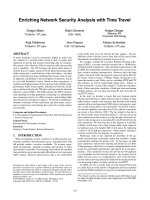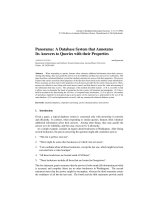Internetworking with TCP/IP- P9 pot
Bạn đang xem bản rút gọn của tài liệu. Xem và tải ngay bản đầy đủ của tài liệu tại đây (479.96 KB, 10 trang )
48
Review
Of
Underlying Network Technologies
Chap.
2
2.1 1.2 Point-To-Point Networks
We said that Wide Area Networks are usually composed of dedicated packet
switches interconnected by data circuits leased from a telephone company. Phone com-
panies originally designed such circuits to carry digitized voice calls; only later did their
use in data networks become important. Consequently, the data rates of available cir-
cuits are not powers of ten. Instead, they have been chosen to carry multiples of
64
Kbps because a digitized voice call uses an encoding known as
Pulse
Code Modulation
(PCM),
which produces
8000
samples per second, where each sample is
8
bits.
The table in Figure
2.16
lists a few common data rates used in North America and
Europe.
Name Bit Rate Voice Circuits Location
-
0.064 Mbps 1
TI 1.544 Mbps 24 North America
T2 6.312 Mbps 96 North America
T3 44.736 Mbps 672 North America
El 2.048 Mbps 30 Europe
E2 8.448 Mbps 120 Europe
E3 34.368 Mbps 480 Europe
Figure
2.16
Example data rates available on digital circuits leased from a
telephone company. The rates
were
chosen to encode multiple
voice calls.
Higher rate digital circuits are also available. In addition to standards that specify
the transmission of high data rates over copper, the phone companies have developed
standards for transmission of the same rates over optical fiber. The table in Figure
2.17
contains examples. Of course, circuits that operate at such high data rates are consider-
ably more expensive than circuits that operate at lower rates.
Standard Name Optical Name Bit Rate Voice Circuits
STS-1
OC-1 51.840 Mbps
81 0
STS-3
OC-3 155.520 Mbps
2430
STS-12
OC-12 622.080 Mbps
9720
STS-24 OC-24
1,244.1 60
Mbps 19440
STS-48 OC-48
2,488.320 Mbps 38880
Figure
2.17
Example
data
rates of high-capacity circuits that can
be
leased
from phone companies. Optical fiber is used to achieve such
high rates over long distances.
Sec.
2.11
Other
Technologies
Over
Which
TCPAP
Has
Been
Used
49
From TCPhP's point of view, any communication system that connects exactly
two computers is known as a
point-to-point network.
Thus, a leased data circuit
between two computers is an example of a point-to-point network. Of course, using the
term "network" to describe a connection between two computers stretches the concept.
However, we will learn that viewing a connection as a network helps maintain con-
sistency. For now, we only need to note that a point-to-point network differs from con-
ventional networks in one significant way: because only two computers attach, no
hardware addresses are used. When we discuss internet address binding, the lack of
hardware addresses will make point-to-point networks an exception.
Another interesting use of TCPhP pioneered by CSNET involves running TCPAP
protocols over the dial-up voice network (i.e., the telephone system). CSNET member
sites that used the Internet infrequently could not justify the cost of a leased line con-
nection. For such sites, CSNET developed a dial-up
IF'
system that worked as expected:
whenever a connection was needed, software at the member's site used a modem to
form a connection to the CSNET hub over the voice telephone network.
A
computer at
the hub answered the phone call and, after obtaining valid authorization, began to for-
ward traffic between the site and other computers on the Internet. Dialing introduced a
delay after the first packet was sent. However, for automated services like electronic
mail, the delay was unnoticeable.
Dialup internet access provides another example of a point-to-point network. From
the
TCP/IP view, dialing a telephone call is equivalent to running a wire. Once the call
has been answered by a modem on the other end, there is a connection from one com-
puter directly to another, and the connection stays in place as long as needed.
2.1
1.4
Other Token Ring Technologies
FDDI is not the first token ring network technology; token ring products have ex-
isted for nearly twenty years. For example, IBM produces a popular token ring LAN
technology. Early versions of the IBM token ring operated at 4 Mbps; later versions
operate at
16
Mbps. Like other token ring systems, an IBM token ring network consists
of a loop that attaches to all computers. A station must wait for a token before
transmitting, and sends the token along after transferring a packet.
An
older token ring technology designed by Proteon Corporation employs a novel
hardware addressing scheme that will be used in a later chapter to illustrate one of the
ways TCP/IP uses hardware addresses. Called a
proNET
network, the technology per-
mits customers to choose a hardware address for each computer. Unlike an Ethernet, in
which each interface board contains a unique address assigned by the manufacturer, a
proNET interface board contains eight switches that must be set before the interface is
installed in a computer. The switches form
a
number in binary between
0
and 255, in-
clusive.
A
given proNET network could have at most 254 computers attached because
address
255
was reserved for broadcast and address
0
was not used. When first instal-
50
Review
Of
Underlying Network Technologies
Chap.
2
ling a proNET network, a network administrator chose a unique address for each com-
puter. Typically, addresses were assigned sequentially, starting with
1.
A
technology that permits customers to assign hardware addresses has advantages
and disadvantages. The chief disadvantage arises from the potential for problems that
occur
if
a network administrator accidentally assigns the same address to two comput-
ers. The chief advantage arises from ease of maintenance:
if
an interface board fails, it
can
be
replaced without changing the computer's hardware address.
2.1
1.5
Wireless Network Technologies
One of the most interesting
ARPA
experiments in packet switching resulted in a
packet radio
technology that uses broadcast radio waves to carry packets. Designed for
a military environment in which stations might
be
mobile, packet radio includes
hardware and software that allow sites to find other sites, establish point-to-point com-
munication, and then use the point-to-point
cornmunication to carry packets. Because
sites change geographic location and may move out of
cornmunication range, the sys-
tem must constantly monitor connectivity and recompute routes to reflect changes
in
to-
pology.
An
operational packet radio system was built and used to demonstrate TCPJIP
communication between a remote packet radio site and other sites on the Internet.
In recent years, a wide variety of wireless networking equipment has become avail-
able commercially. Wireless LAN use spread spectrum techniques such as direct
sequencing or frequency hopping to provide data connections among a set of computers
inside
a
building. The transmitters and antennas for such equipment are small and
lightweight. The equipment can be attached to a portable notebook computer, making it
convenient to move around an area such as an office building while remaining in com-
munication.
Wireless broadband technology, originally developed as an alternative to cable
television, is being used to transmit data. Known as
Multichannel Multipoint Distribu-
tion System (MMDS),
the scheme has sufficient capacity to provide data rates as fast as
those offered by the popular
Digital Subscriber Line (DSL)
technologies that deliver
high data rates over copper telephone wires.
Cellular technology, which was originally designed for voice networks, has also
been adapted to carry data. The chief advantage of a cellular system is the speed with
which it allows users to move. Because the technology was designed to maintain voice
communication even if a user travels by car, the underlying hardware can easily main-
tain contact with a mobile unit while transferring a stream of packets.
2.1 2
Summary And Conclusion
We have reviewed several network hardware technologies used by the TCPIIP pro-
tocols, ranging from inexpensive Local Area Network technologies like Ethernet and
FDDI to expensive Wide Area Network technologies that use leased digital circuits to
provide backbones. We have also seen that it is possible to
run
the TCP/IP protocols
Sec. 2.12 Summary
And
Conclusion
51
over other general-purpose network protocols using a technique called tunneling. While
the details of specific network technologies are not important, a general idea has em-
erged:
The
TCPLP
protocols are extremely flexible; almost any underlying
technology can be used to transfer
TCPAP
trafic.
FOR FURTHER STUDY
Early computer communication systems employed point-to-point interconnection,
often using general-purpose serial line hardware that McNamara [I9821 describes.
Metcalf and Boggs [I9761 introduces the Ethernet with a
3
Mbps prototype version.
Digital
et. al.
[I9801 specifies the original 10 Mbps Ethernet standard, with IEEE stan-
dard 802.3 reported in Nelson [1983]. Shoch, Dalal, and Redell [I9821 provides an his-
torical perspective of the Ethernet evolution. Related work on the
ALOHA
network is
reported in Abramson [1970], with a survey of technologies given by Cotton [1979].
Token passing ring technology is proposed in Farmer and Newhall [1969]. Miller
and Thompson
[1982],
as
well as Andrews and Shultz [1982], provide summaries.
Another alternative, the slotted ring network, is proposed by Pierce [1972]. For
a
com-
parison of technologies, see Rosenthal [1982].
For more infom~ation on the ARPANET see Cerf [1989] and BBN [1981]. The
ideas behind X25NET are summarized in Comer and Korb [1983]; Lanzillo and Par-
tridge [January 19891 describes dial-up
IP.
De Prycker [I9931 describes Asynchronous
Transfer Mode and its use for wide area services. Partridge [I9941 surveys many giga-
bit technologies, including
ATM,
and describes the internal structure of high speed
switches.
EXERCISES
2.1
Find out which network technologies your site uses.
2.2
What is the maximum size packet that can
be
sent on a high-speed network like Network
System Corporation's Hyperchannel?
23
If your site uses Ethernet hub technology, find out how many connections can
be
attached
to a single hub. If your site has multiple hubs (e.g., one on each floor of a building), find
out how the hubs communicate.
2.4
What are the advantages and disadvantages of tunneling?
25
Read the Ethernet standard to find exact details of the inter-packet gap and preamble size.
What is the maximum steady-state rate at which Ethernet can transport data?
52
Review
Of
Underlying Network Technologies
Chap.
2
2.6
What characteristic of a satellite communication channel is most desirable? Least desir-
able?
2.7
Find a lower bound on
the
time it takes to transfer a
5
megabyte file across a network that
operates at:
28.8
Kbps,
1.54
Mbps,
10
Mbps,
100
Mbps, and 2.4 Gbps.
28
Does
the processor, disk, and internal bus on your computer operate fast enough to send
data from a disk file at
2
gigabits per second?
Internetworking Concept
And Architectural Model
3.1
Introduction
So far we have looked at the low-level details of transmission across individual
data
networks, the foundation on which all computer communication is built. This
chapter makes a giant conceptual leap by describing a scheme that allows us to collect
the diverse network technologies into a coordinated whole. The primary goal is a sys-
tem that hides the details of underlying network hardware while providing universal
communication services. The primary result is a high-level abstraction that provides the
framework for
all
design decisions. Succeeding chapters show how we use this abstrac-
tion to build the necessary layers of internet communication software and how the
software hides the underlying physical transport mechanisms. Later chapters also show
how applications use the resulting communication system.
3.2
Application-Level Interconnection
Designers have taken two different approaches to hiding network details, using ap-
plication programs to handle heterogeneity or hiding details in the operating system.
Early heterogeneous network interconnections provided uniformity through application-
level programs called
application gateways.
In such systems, an application-level pro-
gram,
executing on each computer in the network, understands the details of the net-
work connections for that computer, and interoperates across those connections with ap-
plication programs on other computers. For example, some electronic mail systems
54
Internetworking Concept
And
Architectural Model Chap.
3
consist of mail programs that are each configured to forward a memo to a mail program
on the next computer. The path from source to destination may involve many different
networks, but that does not matter as long as the mail systems on
all
the machines
cooperate by forwarding each message.
Using application programs to hide network details may seem natural at first, but
such an approach results in limited, cumbersome communication. Adding new func-
tionality to the system means building a new application program for each computer.
Adding new network hardware means modifying existing programs (or creating new
programs) for each possible application.
On
a given computer, each application pro-
gram
must understand the network connections for the computer, resulting in duplica-
tion of code.
Users who are experienced with networking understand that once the interconnec-
tions grow to hundreds or thousands of networks, no one can possibly build all the
necessary application programs. Furthermore, success of the step-at-a-time communica-
tion scheme requires correctness of
all
application programs executing along the path.
When an intermediate program fails, the source and destination remain unable to detect
or control the problem. Thus, systems that use intermediate applications programs can-
not guarantee reliable communication.
3.3
Network-Level Interconnection
The alternative to providing interconnection with application-level programs is a
system based on network-level interconnection. A network-level interconnection pro-
vides a mechanism that delivers small packets of data from their original source to their
ultimate destination without using intermediate application programs. Switching small
units of data instead of files or large messages has several advantages. First, the
scheme maps directly onto the underlying network hardware, making it extremely effi-
cient. Second, network-level interconnection separates data communication activities
from application programs, permitting intermediate computers to handle network traffic
without understanding the applications that are sending or receiving it. Third, using
network connections keeps the entire system flexible, making it possible to build gen-
eral purpose communication facilities. Fourth, the scheme allows network managers to
add new network technologies by modifying or adding a single piece of new network
level software, while application programs remain unchanged.
The key to designing universal network-level interconnection can be found in an
abstract communication system concept known as
internetworking.
The internetwork,
or
internet,
concept is an extremely powerful one. It detaches the notions of communi-
cation from the details of network technologies and hides low-level details from the
user. More important, it drives all software design decisions and explains how to han-
dle physical addresses and routes. After reviewing basic motivations for internetwork-
ing, we will consider the properties of an internet in more detail.
We begin with two fundamental observations about the design of communication
systems:
Sec.
3.3
Network-Level Interconnection
No single network hardware technology can satisfy all constraints.
Users desire universal interconnection.
The first observation is an economic as well as technical one. Inexpensive Local Area
Networks that provide high speed communication only cover short distances; wide area
networks that span long distances cannot supply local communication cheaply. Because
no single network technology satisfies all needs, we are forced to consider multiple
underlying hardware technologies.
The second observation is self-evident. Ultimately, users would like to be able to
communicate between any two points. In particular, we desire a communication system
that is not constrained by the boundaries of physical networks.
The goal is to build a unified, cooperative interconnection of networks that sup-
ports a universal communication service. Within each network, computers will use
underlying technology-dependent communication facilities like those described in
Chapter
2.
New software, inserted between the technology-dependent communication
mechanisms and application programs, will hide the low-level details and make the col-
lection of networks appear to be a single large network. Such an interconnection
scheme is called an
internetwork
or
internet.
The idea of building an internet follows a standard pattern of system design:
researchers imagine a high-level computing facility and work from available computing
technology, adding layers of software until they have a system that efficiently imple-
ments the imagined high-level facility. The next section shows the first step of the
design process by defining the goal more precisely.
3.4
Properties
Of
The Internet
The notion of universal service is important, but it alone does not capture all the
ideas we have in mind for a unified internet because there can be many implementations
of universal services. In our design, we want to hide the underlying internet architec-
ture from the user. That is, we do not want to require users or application programs to
understand the details of hardware interconnections to use the internet. We also do not
want to mandate a network interconnection topology. In particular, adding a new net-
work to the internet should not mean connecting to a centralized switching point, nor
should it mean adding direct physical connections between the new network and all ex-
isting networks. We want to be able to send data across intermediate networks even
though they are not directly connected to the source or destination computers. We want
all computers in the internet to share a universal set of machine identifiers (which can
be thought of as
names
or
addresses).
Our notion of a unified internet also includes the idea of network independence in
the user interface. That is, we want the set of operations used to establish cornrnunica-
tion or to transfer data to remain independent of the underlying network technologies
and the destination computer. Certainly, a user should not have to understand the net-
work interconnection topology when creating or using application programs that com-
municate.
56
Internetworking Concept And Architectural Model Chap. 3
3.5
Internet Architecture
We have seen how computers connect to individual networks. The question arises,
"How are networks interconnected to form an internetwork?" The answer has two
parts. Physically, two networks can only be connected by a computer that attaches to
both of them.
A
physical attachment does not provide the interconnection we have in
mind, however, because such a connection does not guarantee that the computer will
cooperate with other machines that wish to communicate. To have a viable internet, we
need special computers that are willing to transfer packets from one network to another.
Computers that interconnect two networks and pass packets from one to the other are
called
internet gateways
or
internet routersf.
Consider an example consisting of two physical networks shown in Figure
3.1.
In
the figure, router
R
connects to both network
I
and network
2.
For
R
to act
as
a
router,
it must capture packets on network
1
that are bound for machines on network
2
and
transfer them. Similarly,
R
must capture packets on network
2
that are destined for
machines on network
I
and transfer them.
Figure
3.1
Two physical networks interconnected by
R,
a router
(IP
gateway).
In the figure, clouds are used to denote physical networks because the exact
hardware is unimportant. Each network can be a LAN or a WAN, and each may have
many computers attached or a few computers attached.
3.6
Interconnection Through IP Routers
Although it illustrates the basic connection strategy, Figure
3.1
is quite simplistic.
In an actual internet that includes many networks and routers, each router needs to
know about the topology of the internet beyond the networks to which it connects. For
example, Figure
3.2
shows three networks interco~ectd by two routers.
tThe original literature used the term
IP
gateway.
However, vendors have adopted the term
IP
router
-
the two terms are used interchangeably throughout this text.
Sec.
3.6
Interconnection Through
IP
Routers
Figure
3.2
Three
networks interconnected
by
two routers.
In this example, router
R,
must transfer from network
I
to network
2
all packets des-
tined for computers on either network
2
or network
3.
For a large internet composed of
many networks, the router's task of making decisions about where to send packets be-
comes more complex.
The idea of a router seems simple, but it is important because it provides a way to
interconnect networks, not just computers. In fact, we have already discovered the prin-
ciple of interconnection used throughout an internet:
In a
TCPBP
internet, special computers called
IP
routers
or
IP gate-
ways
provide interconnections among physical networks.
You might suspect that routers, which must each know how to forward packets to-
ward their destination, are large machines with enough primary or secondary memory to
hold information about every computer in the internet to which they attach.
In
fact,
routers used with TCPAP internets are usually small computers. They often have little
disk storage and modest main memories. The trick to building
a
small internet router
lies in the following concept:
Routers use the destination network, not the destination computer,
when forwarding a packet.
If packet forwarding is based on networks, the amount of information that a router
needs to keep is proportional to the number of networks in the internet, not the number
of computers.
Because routers play a key role in internet communication, we will return to them
in later chapters and discuss the details of how they operate and how they learn about
routes. For now, we will assume that it is possible and practical to have correct routes
for all networks in each router in the internet. We will also assume that only routers
provide connections between physical networks in an internet.









